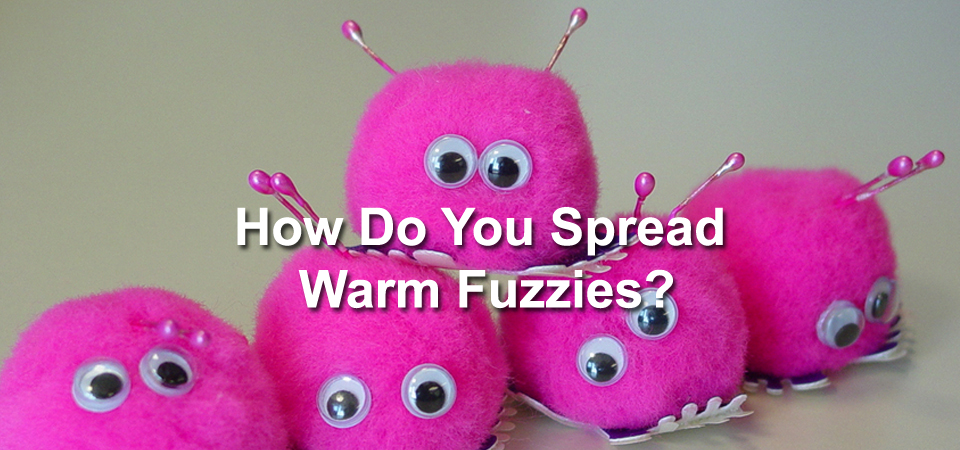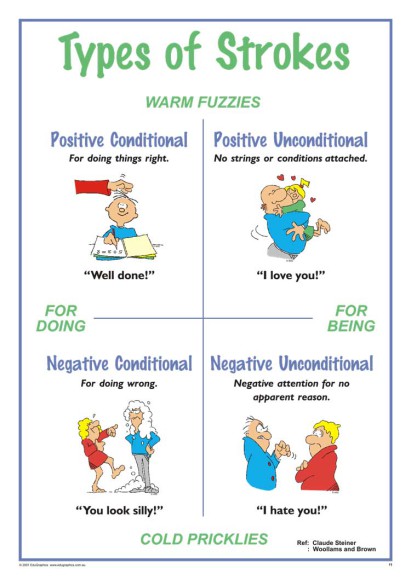
by Claude M. Steiner
Once upon a time, a long time ago, there lived two happy people called Tim and Maggie with their two children, John and Lucy. To understand how happy they were you have to understand how things were in those day
You see in those happy days everyone was given a small, soft Fuzzy Bag when born. Any time a person reached into this bag they were able to pull out a Warm Fuzzy. Warm Fuzzies were very much in demand because whenever someone was given a Warm Fuzzy it made them feel warm and fuzzy all over.
In those days it was very easy to get Warm Fuzzies. Anytime that somebody felt like it, he might walk up to you and say, “I’d like to have a Warm Fuzzy.” You would then reach into your bag and pull out a Fuzzy the size of a child’s hand. As soon as the Fuzzy saw the light of day it would smile and blossom into a large, shaggy, Warm Fuzzy. When you laid the Warm Fuzzy on the person’s head, shoulder or lap it would snuggle up and melt right against their skin and make them feel good all over.
People were always asking each other for Warm Fuzzies, and since they were always given freely, getting enough of them was never a problem. There were always plenty to go around, and so everyone was happy and felt warm and fuzzy most of the time.
One day a bad witch who made salves and potions for sick people became angry because everyone was so happy and feeling good and no one was buying potions and salves. The witch was very clever and devised a very wicked plan. One beautiful morning while Maggie was playing with her daughter the witch crept up to Tim and whispered in his ear,
“See here, Tim, look at all the Fuzzies that Maggie is giving to Lucy. You know, if she keeps it up she is going to run out and then there won’t be any left for you!”
Tim was astonished. He turned to the witch and asked, “Do you mean to tell me that there isn’t a Warm Fuzzy in our bag every time we reach into it?”.
And the witch answered, “No, absolutely not, and once you run out, that’s it. You don’t have any more.” With this the witch flew away on a broom, laughing and cackling all the way.
Tim took this to heart and began to notice every time Maggie gave away a Warm Fuzzy. He got very worried because he liked Maggie’s Warm Fuzzies very much and did not want to give them up. He certainly did not think it was right for Maggie to be spending all her Warm Fuzzies on the children and other people.
Tim began to complain or sulk when he saw Maggie giving Warm Fuzzies to somebody else, and because Maggie loved him very much, she stopped giving Warm Fuzzies to other people as often, and reserved most of them for him.
The children watched this and soon began to get the idea that it was wrong to give Warm Fuzzies any time you were asked or felt like it. They too became very careful. They would watch their parents closely and whenever they felt that one of their parents was giving too many Fuzzies to others, they felt jealous and complained and sometimes even had a tantrum. And even though they found a Warm Fuzzy every time they reached into their bag they began to feel guilty whenever they gave them away so they reached in less and less and became more and more stingy with them.
Before the witch, people used to gather in groups of three, four or five, never caring too much who was giving Warm Fuzzies to whom. After the coming of the witch, people began to pair off and to reserve all their Warm Fuzzies for each other, exclusively. When people forgot to be careful and gave a Warm Fuzzy to just anybody they worried because they knew that somebody would probably resent sharing their Warm Fuzzies.
People began to give less and less Warm Fuzzies, and felt less warm and less fuzzy. They began to shrivel up and, occasionally, people would even die from lack of Warm Fuzzies. People felt worse and worse and, more and more, people went to the witch to buy potions and salves even though they didn’t really seem to work.
Well, the situation was getting very serious indeed. The bad witch who had been watching all of this didn’t really want the people to die (since dead people couldn’t buy his salves and potions), so a new plan was devised.
Everyone was given, free of charge, a bag that was very similar to the Fuzzy Bag except that this one was cold while the Fuzzy Bag was warm. Inside of the witch’s bag were Cold Pricklies. These Cold Pricklies did not make people feel warm and fuzzy; in fact they made them feel cold and prickly instead. But the Cold Pricklies were better than nothing and they did prevent peoples’ backs from shriveling up.
So, from then on, when somebody asked for a Warm Fuzzy, people who were worried about depleting their supply would say, “I can’t give you a Warm Fuzzy, but would you like a Cold Prickly instead?”
Sometimes, two people would walk up to each other, thinking they maybe they could get a Warm Fuzzy this time, but one of them would change his mind and they would wind up giving each other Cold Pricklies instead. So, the end result was that people were not dying anymore but a lot of people were very unhappy and feeling very cold and prickly indeed.
The situation got very complicated since the coming of the witch because there were fewer and fewer Warm Fuzzies around and Warm Fuzzies which used to be free as air, became extremely valuable.
This caused people to do all sorts of things in order to get Warm Fuzzies. People who could not find a generous partner had to buy their Warm Fuzzies and had to work long hours to earn the money.
Some people became “popular” and got a lot of Warm Fuzzies without having to give any back. These people would then sell their Warm Fuzzies to people who were “unpopular” and needed them to feel that life was worth living.
Another thing which happened was that some people would take Cold Pricklies–which were everywhere and freely available-and coated them white and fluffy so that they almost looked like Warm Fuzzies. These fake Warm Fuzzies were really Plastic Fuzzies, and they caused additional problems.
For instance, two or more people would get together and freely give each other Plastic Fuzzies. They expected to feel good, but they came away feeling bad instead. People got very confused never realizing that their cold, prickly feelings were because they had been given a lot of Plastic Fuzzies.
So the situation was very, very dismal and it all started because of the coming of the witch who made people believe that some day, when least expected, they might reach into their Warm Fuzzy Bag and find no more.
Not long ago, a young woman with big hips came to this unhappy land. She seemed not to have heard about the bad witch and was not worried about running out of Warm Fuzzies. She gave them out freely, even when not asked. They called her the Hip Woman and disapproved of her because she was giving the children the idea that they should not worry about running out of Warm Fuzzies. The children liked her very much because they felt good around her and they began to follow her example giving out Warm Fuzzies whenever they felt like it.
This made the grownups very worried. To protect the children from depleting their supplies of Warm Fuzzies they passed a law. The law made it a criminal offense to give out Warm Fuzzies in a reckless manner or without a license. Many children, however, seemed not to care; and in spite of the law they continued to give each other Warm Fuzzies whenever they felt like it and always when asked. Because they were many, many children, almost as many as grown ups, it began to look as if maybe they would have their way.
As of now its hard to say what will happen. Will the grownups laws stop the recklessness of the children?
Are the grownups going to join with the Hip Woman and the children in taking a chance that there will always be as many Warm Fuzzies as needed?
Will they remember the days their children are trying to bring back when Warm Fuzzies were abundant because people gave them away freely ?
The struggle spread all over the land and is probably going on right were you live. If you want to, and I hope you do, you can join by freely giving and asking for Warm Fuzzies and being as loving and healthy as you can.
![]()




